Hide and Seek
A play in three acts by Stanley Mann and Roger MacDougall. Opened at the
Ethel Barrymore
Theatre, New York City, April 2, 1957, and ran for 7 performances. Produced by
Fred F. Finklehoffe, Mark Marvin and Gabriel Katska. Staged by Reginald Denham.
Setting and lighting by Ralph Alswang; costumes by Virginia Volland. The play
closed April 6, 1957.
|
Cast of Characters
|
Saul |
Peter Lazer |
|
Michael |
Walter Brooke |
|
Judy |
Marilyn Siegel |
|
Ann Richards |
Geraldine Fitzgerald |
|
Janice |
Dolores Dorn-Heft |
|
Tom Richards |
Franchot Tone /
Barry Morse |
|
Sir Roger Johnson |
Basil Rathbone |
|
Margo Johnson |
Isobel Elsom |
|
Gregson |
Carl Harbord |
| |
|
|
| |
|
| The entire action takes place inside and outside a
cottage in Warwick, England. Act I — A morning in spring
Act II — That evening
Act III — Twenty minutes later |
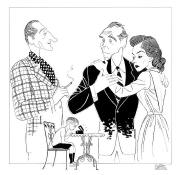
a drawing by Georg Wachsteter of Basil Rathbone, Franchot Tone, Geraldine Fitzgerald,
and
Peter Lazer (the boy) |
The play explores the moral problems of a nuclear scientist, Tom
Richards, who is forced to work on a government project aiming to destroy
the enemy via mutations before they are born. A crisis develops when it is
believed that his young son has stolen a radioactive
egg from the laboratory where his father works. The incident provokes the
father into quitting his job. Rathbone plays the lead scientist on the
project, Richards's boss.
Prior to opening on Broadway, Hide and Seek was performed at
the Playhouse Theatre, Wilmington, Delaware (March 13-16), the
Sam S. Shubert Theatre, Washington DC (March 18-23) and the Shubert Theatre, New Haven,
Connecticut (March 25-30).
The April 3 edition of Variety reports that the eight
performances in New Haven grossed $20,700—an
amount it deemed "not bad."
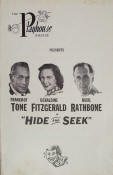
playbill for the performances in Wilmington, Delaware
(March 13-16) |
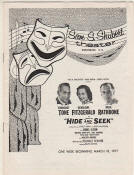
playbill for the performances in Washington, DC
(March 18-23) |
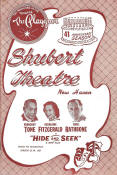
playbill for the performances in New Haven,
Connecticut (March 25-30) |
Franchot Tone played the role of "Tom
Richards" in the out-of-town tryouts in Washington DC, Wilmington, and New
Haven. Tone then left the show. One report stated that his leaving was due
to illness. The New York Times, however, reported that Tone felt the
part was "ill-suited" for him (N.Y. Times, March 23, 1957). Tone left
Hide and Seek, and joined the cast of Eugene O'Neill's play A Moon
for the Misbegotten. He starred opposite Wendy Hiller.
Replacing Franchot Tone, Barry Morse
joined the cast just a couple of days before the show opened on Broadway.
Photos (by Friedman-Abeles) are from the pre-Broadway production.
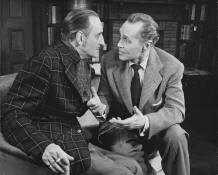
Basil Rathbone and Franchot Tone |
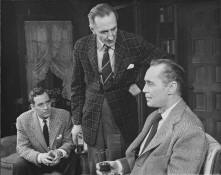
Walter Brooke,
Basil Rathbone and Franchot Tone |
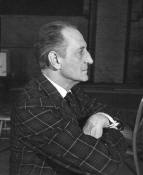
Basil Rathbone |
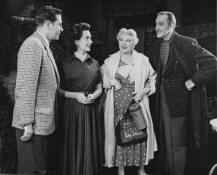
Walter Brooke, Geraldine Fitzgerald, Isobel Elsom, Basil Rathbone |
When the play opened on Broadway, it received a number of bad reviews. Variety
reported that after seven performances, the show grossed about $8,500.
(Compare that to the nearly $21,000 grossed for eight performances in New
Haven.) The play closed on April 6 at a loss of about $67,500 on a $75,000
investment. (Variety, April 10, 1957, p. 82)
| A play about a British nuclear scientist at work on a Government
project he loathes—for mutilating people before birth. If he quits, however, he
faces being made a security risk. The action involves a lethal radioactive egg
missing from the lab, which is very possible the egg the scientist's young son
is known to have been toting around. This situation injects some scary moments
into the final act; but Hide and Seek puts all its eggs in one basket,
all its theatre into one scene; the play in general is no less talky than
unconvincing, and as full of digressions as of longueurs. — The Best Plays of 1956-57, ed. by Louis Kronenberger
(Dodd, Mead and Co., 1957), pages 364-365. |
The play Hide and Seek was the first writing collaboration by
Stanley Mann and Roger MacDougall. They also collaborated on the screenplay
for The Mouse That Roared (1959).
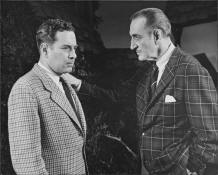
Walter Brooke and Basil Rathbone |
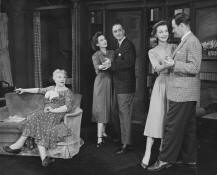
left to right: Isobel Elsom, Geraldine Fitzgerald, Basil Rathbone,
Dolores Dorn-Heft, Walter Brooke |
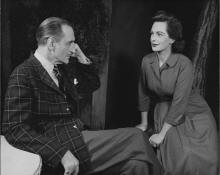
Basil Rathbone and Geraldine Fitzgerald |
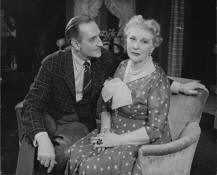
Basil Rathbone and Isobel Elsom |
Roger MacDougall was a Scottish playwright and screenwriter. He is known
for the play Escapade (1953), and the films The Man in the White
Suit (1951) and The Mouse That Roared (1959).
Stanley Mann was a Canadian playwright and screenwriter. He is known for
the films The Mouse That Roared (1959), The Collector (1965),
Eye of the Needle (1981) and Conan the Destroyer (1984).
| Show on Broadway It's possible to write a
very small play about a very large subject. Stanley Mann and Roger
MacDougall have done just that in "Hide and Seek." Although the theme
of the play is urgent and the dialog references are topical, the style
is antiquated, the form is hackneyed and the drama seems spurious and
foolish.
"Hide and Seek" presents a moral dilemma in terms of hokum meller.
A nuclear scientist, already spiritually estranged from his wife by
the necessary secrecy of his work, and guilt-plagued to be developing
a super-weapon capable of destroying all human life, is shocked into
full consciousness of the enormity of his situation when his small son
gets hold of a malignantly contaminated chicken's egg.
It turns out, of course, that the egg isn't actually the lethal one
missing from the top-secret laboratory. But the scare has galvanized
their consciences. The final scenes have reasonable reality and
movement, but the first two acts are unbelievable and seemingly
interminable.
The situations are trite and the authors apparently have a genius
for cliche-packed lines. The staging by the normally capable Reginald
Denham seems almost deliberately stilted and the acting, for the most
part, self-consciously awkward. The single setting by Ralph Alswang
looks cramped and artificial, and even the costumes by Virginia
Volland are not too attractive. Clearly, this is a case of poor
quality being contagious.
Only two cast members emerge creditably. Top-starred Geraldine
Fitzgerald is at least plausible as the scientist's querulous wife, at
least in the taut final scenes, and Peter Lazer is appealing as her
moppet son. Basil Rathbone, costarred as a top-brass scientist, gives
an overly mannered performance, and British actor Barry Morse, also
costarred, seems curiously rigid as the unhappy scientist-father.
Among the featured supporting players, Walter Brooke is unable to
give conviction to the role of a woman-shy scientist (he has good
reason to be jittery, as he proposes the first time he's alone with a
girl). Dolores Dorn-Heft seems affected as the young widow who snares
him, Isobel Elsom is blandly maternal as the head scientist's
childless wife, and Marilyn Siegel and Carl Harbord are acceptable as
a respective moppet neighbor and atomic researcher.
Hobe.
— Variety, April 10, 1957, p. 84 |
Barry Morse, a well-known British and Canadian actor, made his Broadway
debut in Hide and Seek. He gained fame in the USA for his role as Lt.
Gerard in the television series The Fugitive (1963-1967).
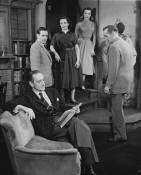
clockwise from left: Basil Rathbone, Walter Brooke,
Geraldine Fitzgerald, Dolores Dorn-Heft, Franchot Tone |
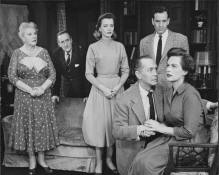
left to right: Isobel Elsom, Basil Rathbone, Dolores
Dorn-Heft, Walter Brooke, and seated in front: Franchot Tone and Geraldine Fitzgerald |
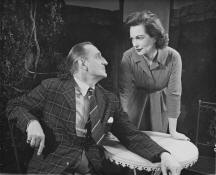
Basil Rathbone and Geraldine Fitzgerald |
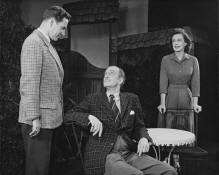
Walter Brooke, Basil Rathbone and Geraldine Fitzgerald |
Geraldine Fitzgerald was an Irish actress who appeared in such films as
Dark Victory (1939) and Wuthering Heights (1939).
| Top-secret scientific matters were the main order of business in this play.
During the concluding moments of this mixture of suspense drama and
philosophical play, the cast members were dressed in the sort of clothing that
scientists wear for protection against dangerous materials. There are some
reasonably exciting moments in the last act, as three physicists and their
families search for a boy who, they are convinced, is using a radioactive egg as
a plaything. But by then it was much too late, despite a generally good
production. All hands had been exposed to something much more dangerous. It was
dramatic, not atomic. Far from blending, the elements in the script are
inevitably at odds. The philosophical stretches, dealing with the responsibility
of nuclear science to humanity, stifle the suspense potential—and in turn are
compromised by it on anything like a serious level. Hide and Seek becomes
something both hybrid and weak. — Theatre Arts magazine, June 1957 |
The following photos appear to have been taken during a rehearsal.
Rehearsals began February 18, 1957.
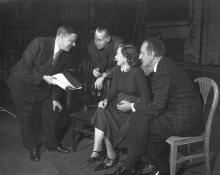
Director Reginald Denny, Franchot Tone, Geraldine Fitzgerald, Basil Rathbone |
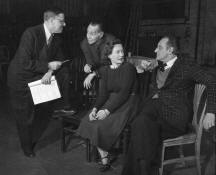
Director Reginald Denny, Franchot Tone, Geraldine Fitzgerald, Basil Rathbone |
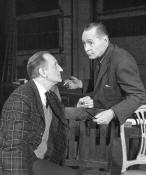
Basil Rathbone and Franchot Tone |
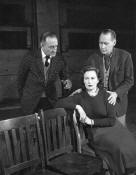
Basil Rathbone, Geraldine Fitzgerald, and Franchot Tone |
Isobel Elsom was a British actress who appeared in numerous films
including Of Human Bondage (1946), Monsieur Verdoux (1947),
and My Fair Lady (1964).
|
Wrong Egg
Ludicrously incompetent plays are, of course, no
novelty on Broadway ... but somehow they never fail to startle me a
little. ... I still think vaguely of New York as the capital of
dramatic art in America, and the appearance of an exhibit completely
without merit, even by the standards prevailing on the television, is
always something of a shock. ...
In this roundabout fashion, we come to "Hide and
Seek," a species of melodrama that was inflicted on seven smoldering
audiences last week at the Ethel Barrymore. This work ... had to do
with some of the possible side effect of atomic research. I'm obliged
to admit that I wasn't as attentive as I might have been after the
entertainment had been in progress for twenty minutes or so, but the
general idea appeared to be that a young British physicist who started
out to employ his gifts for the benefit of humanity had been persuaded
to devote them to destruction instead, and had, in fact, invented a
method of treating hens' eggs so that they not only would hatch out
monsters but would also, even while still intact, give off rays
capable of slaughtering anybody in the vicinity. The morality of this
altered purpose was debated with lofty incoherence for quite a while
(Miss Fitzgerald, as the scientist's wife, was clearly opposed to the
wiping out of her species; Mr. Rathbone, as his government employer,
felt just as strongly that all means are justified in total warfare),
but the play didn't really get under way until it was discovered that
the eight-year-old son of the house was in possession of an egg that
might or might not be one of those doctored by his father. The rest of
the evening was devoted to tracking down the hypothetically
contaminated tot, and this was a very odd spectacle indeed —
especially in the final sequences, when the adult members of the cast
got themselves up in rubber-and-isinglass space suits and closed in
slowly on the horrified child. In the event that the Herald Tribune
is not the paper of your choice, I would like to report that its
critic, Mr. Walter Kerr, defined "Hide and Seek" as the first show in
history to lay a radioactive egg.
—Wolcott
Gibbs
— The
New Yorker, vol. 33, April 13, 1957 |
Walter Brooke was an American actor who appeared in The Graduate
(1967), Tora! Tora! Tora! (1970), and numerous television series.
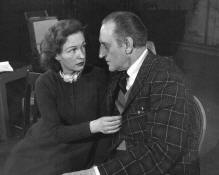
Geraldine Fitzgerald, Basil Rathbone |
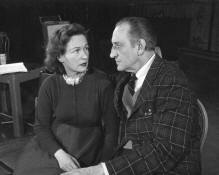
Geraldine Fitzgerald, Basil Rathbone |
Peter Lazer, who played Saul, the boy who apparently stole the
radioactive egg, continued acting in film and television during the 1950s
and 1960s.
Mann-MacDougall Play Opens at
Barrymore
By Brooks AtkinsonIn "Hide and Seek," which opened at the Ethel
Barrymore last evening, Stanley Mann and Roger MacDougall ask one of
the most disturbing questions of the century. Should a nuclear
scientist, taking orders from his government, go on working on
projects that will kill or mutilate human beings?
The authors illustrate their argument in the last act. It appears
that the scientist's son has got hold of radioactive material that
will kill him and contaminate everyone around him. Everyone wants to
separate him from the material. On the other hand, nearly everybody
wants to remain at a safe distance. ...
The final act makes very vivid the human values of an ethical
question. ... "Hide and Seek" is a play with a mission. It is also a
play with banal ideas about the behavior of characters on the stage,
with a lot of small talk that verges on the minuscule, a haphazard way
of telling a story and a general air of mechanical contrivance. It has
a sewing circle notion of scientists as men unable to participate in
family life or incapable of falling in love romantically. It's a small
play on a big subject. ...
Nothing in Reginald Denham's direction rescues the play from
dullness. ... Despite the forceful confrontations that make the last
act effective, Mr. Mann and Mr. MacDougall have not really
communicated the purity and the idealism of their thought.
— The New York Times,
April 3, 1957, p. 26 |
Franchot Tone, who left the show just prior to its opening on Broadway,
starred in many plays (such as Green Grow the Lilacs, 1930), films
(such as Mutiny on the Bounty, 1935), and television series (Ben
Casey, 1965-1966).
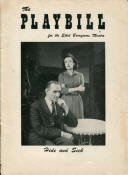
The cover of the playbill for the Ethel Barrymore Theatre |
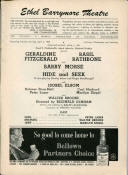
inside page of the playbill for the Ethel Barrymore
Theatre |
Dolores Dorn-Heft, an American actress, was married to Franchot Tone from
1956 to 1959. She appeared in several films and television series. She and
Franchot Tone appeared together in the 1957 film Uncle Vanya (based
on the Chekhov play), which Tone also produced and directed.
| Despite a cast that included Basil Rathbone, Hide and Seek (1957) by Stanley Mann
and Roger MacDougall had but seven New York performances. Rathbone plays nuclear scientist
Sir Roger Johnson, who is working on the development of radioactive eggs,
one of which is stolen, apparently by a spy. Critic John Chapman [of The
Daily News] called it
"a science fiction thriller which failed to thrill." —Marvin
Lachman, The Villainous Stage: Crime Plays on Broadway and in the
West End (McFarland, 2014), p. 121 |
Hide and Seek was originally planned to open at the Belasco
Theatre. In mid-March the Ethel Barrymore Theatre was selected for the play.
But The Greatest Man Alive was set to open at the Ethel Barrymore
Theatre on May 8. If Hide and Seek had been successful, it would have
had to move to a different theatre.

Ethel Barrymore Theatre in 1933 |
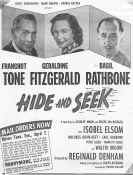
an ad for the play |
Reginald Denham directed Basil Rathbone in two earlier plays:
Obsession (1946) and Sherlock Holmes (1953).
An Egg Steals Show!
However, It's Not a Very Good Show
by John McClainNEW YORK, April 6. There will be a temptation in
many quarters to make some sort of fun out of the fact that "Hide and
Seek," the new drama at the Ethel Barrymore Theater, should really
have been named "The Egg and I." I got this idea fairly soon after the
opening curtain rose, but I figured not to use it on the basis that it
was too easy. Then, arriving at the office where this is written and
looking out on the Times Building with its moving electric sign, what
do I see? This is what I see: "G. L. F. says eggs best food buy ...
tasty eggs ... eggs for pep ... eggs for variety ... fix eggs 100 ways
..." I don't know who or what G. L. F. is, but having just come from
the theater where one egg, seemingly bigger than all of us, had kept
us in our seats for more than two hours, I had to go back on my word.
For this play by Stanley Mann and Roger MacDougall is almost solely
concerned with a group of dedicated British nuclear scientists and the
foment caused when a small boy has apparently run off with an
experimental egg whose radiation will kill every body. This is not, of
course, a conventional egg, but rather a weapon that these savants
have created to direct the course of mankind. This leads to endless
discussion of why such effort should have been diverted to such ends, threatens to disrupt a couple of amiable households,
and rather refutes the G. L. F. claims that eggs are "best food buy."
Finally, everybody is attired in space suits and helmets and nobody
will get within 10 yards of the kid. Could give a lad a lasting
complex. It seemed a ludicrous idea to begin with, and one which
didn't build and capture me as the evening progressed. There is
something innocuous about an egg, and it seemed difficult to share the
horrors of these adults as they crashed around the stage in masks and
leaden draperies looking for the sprout. I'm quite sure that my
breakfast may blow up tomorrow and wreck mid-Manhattan, There are good
people in the cast and the production. Geraldine Fitzgerald plays the
wife of a recalcitrant scientist with extreme enthusiasm and a proper
respect for the enlightenment of a new world. Basil Rathbone is
suave and compelling as the senior researcher. Isobel Elsom is his
loyal and, apparently, unquestioning wife. Other able assists are
offered by Barry Morse, Dolores Dorn-Heft, Carl Harbord, Peter Lazer
(another very capable child actor), Marilyn Siegel and Walter Brooke.
— The Pittsburgh Press,
April 7, 1957, p. 94 |
Carl Harbord, a British actor, appeared in many plays and films,
including Dressed to Kill (1946), which starred Basil Rathbone as
Sherlock Holmes.
Carl Harbord played Inspector Hopkins.
Marilyn Siegel, aka Marilyn Rogers, appeared in a few more plays,
including the Broadway production of The Sound of Music (as Brigitta
von Trapp) from 1959-1962. She also appeared in a few films during the
1960s, and then apparently gave up acting as a career.
|































